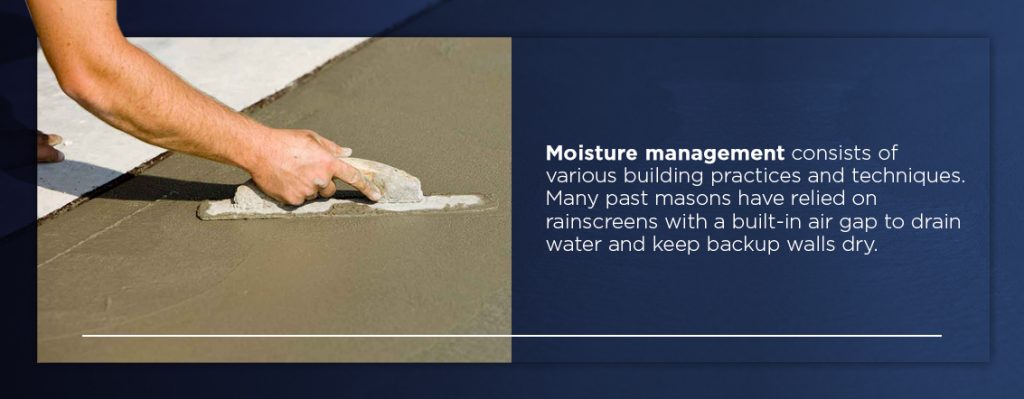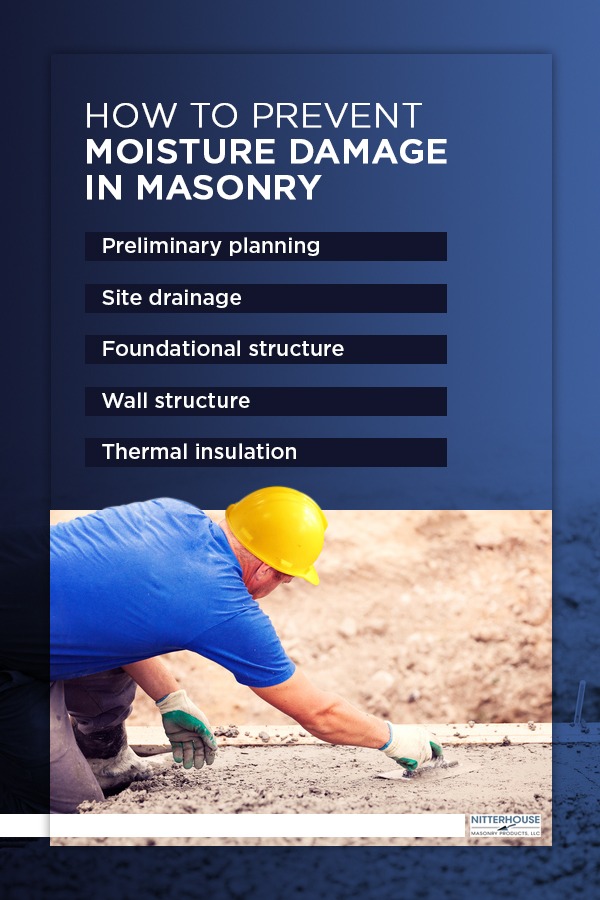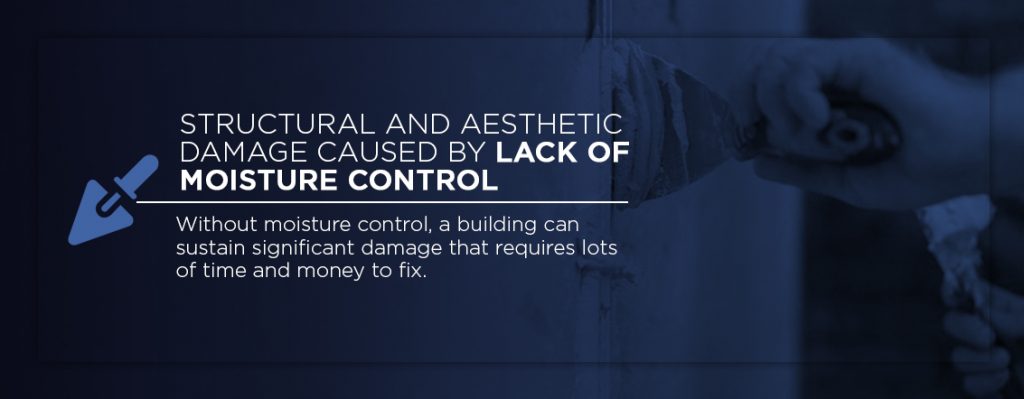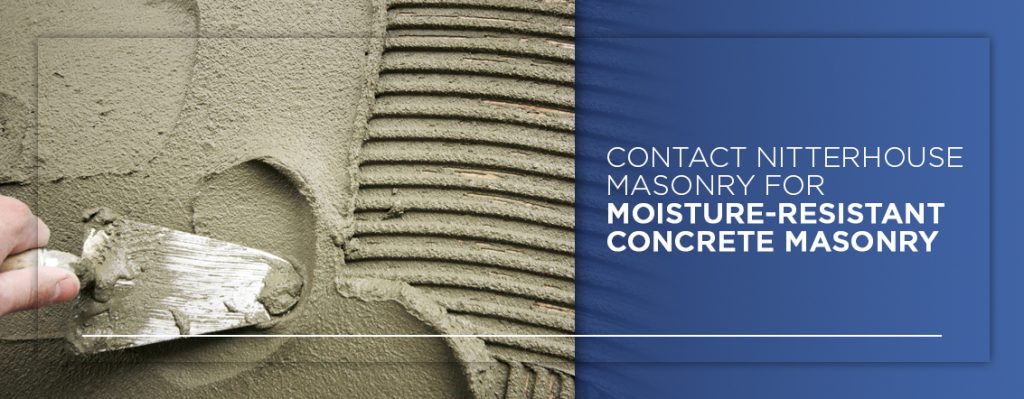
Jump-To:
- What Is Moisture Management in Masonry?
- How to Prevent Moisture Damage in Masonry
- Masonry Design and Installation to Control Moisture During Construction
- Exterior Wall Repellents to Help Prevent Moisture Issues in the Future
- How to Fix Leaky Masonry Walls
- Structural and Aesthetic Damage Caused by Lack of Moisture Control
- Preventing Mold Through Moisture Control
Controlling moisture in masonry is essential to preserving the integrity of your building projects. Condensation proves a pervasive threat to buildings, especially walls and concrete foundations. Above-grade and below-grade water can weaken the structure of a building by causing rotting, corrosion and many more moisture-induced issues. Although concrete doesn’t typically face these specific concerns, it can be susceptible to other complications.
You don’t have to let moisture retention ruin your plans, however. There are many preventative methods you can take to stop the destruction before it occurs. You can skillfully learn how to control moisture in your masonry projects to avoid costly damages and lost time.
What Is Moisture Management in Masonry?

Moisture management consists of various building practices and techniques. Many past masons have relied on rainscreens with a built-in air gap to drain water and keep backup walls dry. However, modern builders have adopted the water-resistive barrier (WRB), which is not always as effective as installing an air gap. Additionally, anchored and adhered stone veneers can retain moisture if installed improperly, which makes it harder to keep the wall dry if the water-resistive barrier is not durable enough.
Some percentage of moisture will always enter the walls or foundations, whether that’s through interior condensation or veneer cracks that let in snow and rain. However, properly managing this dampness ensures that a building maintains its structural integrity throughout its lifetime. Waterproofing methods vary, including the air gap, WRBs, weeps and air vents.
Implementing an air gap can come with some issues, though, if not correctly fitted to the particular project. Using materials like mortar or mesh to keep the space open can result in a clogged cavity and stifled airflow. The best way to incorporate an air gap is to add a rainscreen drainage plane, which extends from the wall’s highest point to its weep holes. Weeps sit at the base of a masonry wall and remove water from the rainscreen — all three elements combine to create an effective drainage system.
How to Prevent Moisture Damage in Masonry

You can block moisture buildup in numerous ways — most only require a bit of knowledge and the use of preventative building strategies. For projects that have already sustained water damage, though, it’s not too late to fix the issues before they grow worse.
Many moisture problems arise from condensation, which results from cold spots within a structure. Cold surfaces have a lower net condensation rate than warm ones. When a surface is chilly, its evaporation rate lowers, meaning fewer molecules of water vapor are required for condensation to occur. Air infiltration and inadequate thermal insulation can facilitate condensation.
Wind-driven rain and snow also pose significant issues for vulnerable masonry systems. Implementing some major adjustments in your project plan, however, can go a long way for preventing moisture problems in masonry:
- Preliminary planning: Before constructing anything, put a design in place for what elements the finished product will incorporate. Building waterproofing components into the structure from the beginning means you won’t have to deal with significant moisture issues later on. Use things like moisture resistant materials — such as concrete masonry — water vapor retarders, air retarders and more to keep water retention to a minimum.
- Site drainage: Poorly managed irrigation systems and water drainage systems can cause water to enter a building. Water should always move away from the structure instead of towards it, which grading can help with. Be sure to install an adequate amount of permeable surfaces around the worksite. Impervious materials can cause stormwater to flood the surrounding area, which can damage foundations.
- Foundational structure: A high-quality masonry system should prevent damage from natural elements. However, it’s impossible to do this if cracks, weak points, vulnerable joints or other signs of poor handiwork are present. Build a foundation with a below-grade drainage system to avoid moisture infiltration and facilitate water diversion. Use vapor retarders with slab-on-grade foundations, and incorporate capillary breaks where necessary. Capillary breaks are water-repelling materials that protect a foundation from capillary action, or water that moves through pores and crevices.
- Wall structure: Ensure the safety and appearance of your walls by designing them with moisture control in mind. As mentioned above, air gaps and rainscreens can help, though flashing is also a crucial element. Flashing refers to any impervious material intended to prevent water infiltration. Along with this measure, design a structure that’s airtight enough to limit airflow — and therefore vapor — with enough ventilation to avoid additional issues like mold.
- Thermal insulation: Insulation can regulate the temperature of a building’s walls, which keep interior surfaces above the dew point. The dew point is the temperature at which water vapor in the air begins to condense and form dew. If you know this number, you can prevent condensation from occurring. Create an air barrier within your wall assembly that consists of durable material, such as spray foam insulation, to allow for better drying.
Masonry Design and Installation to Control Moisture During Construction
Preventing moisture in masonry calls for intricate construction designs. The ideal setup consists of a multi-part defense system, which includes surface protection, internal protection, drainage and drying. The kind of masonry you use will determine how you can employ this strategy to waterproof your building project. You may choose from a few different structural designs when creating your walls and foundations:
- Full bed depth veneers: Full stone veneers are thicker than manufactured thin veneer and typically weigh more. Their densities depend on what kind of stone you use. When installed correctly and combined with water-resistant materials or techniques, they can hold up well against the elements.
- Single wythe walls: Single wythe walls require precise construction and detailing to protect against heat, cold and moisture. That’s because they don’t need a cavity wall, which would provide structural reinforcement in any other case. Wythe walls are one layer thick, though this quality doesn’t take away from their appeal. They can adapt to various finishing options, which is convenient for those who prioritize cost-efficiency and aesthetics in their building projects. Combine it with flashing and water repellents to ensure it can hold up to moisture.
- Manufactured stone thin veneer: A manufactured thin veneer is a surface material you can install onto a solid facing. It’s lightweight and much slimmer than a full stone veneer. To use it as a moisture control seal, you would typically include other components such as oriented strand board, building paper, a drainage mat and a metal lath or diamond mesh. You may also apply a thin mortar coat to the mesh for additional water protection.
Exterior Wall Repellents to Help Prevent Moisture Issues in the Future
In addition to the structural techniques mentioned above, you may use an exterior wall repellent as a hydrophobic element during construction. Repellents serve as effective seals to prevent moisture buildup when applied to concrete masonry units (CMUs) or mortar. They can also enhance a wall’s color or texture and reduce the staining effects of environmental pollutants.
Through the history of masonry, builders have used a few primary types of water repellent mixtures, including tall oils, polymetric and calcium stearate. Manufacturers typically apply the repellent during the production of concrete blocks, though you can buy blocks without the additive. In this case, you’d have to spray the mixture onto the mortar after it cures.
Compared to the other substances, polymetric is the better mixture to use for avoiding moisture damage. It tends to create a better bond between the CMUs and mortar, and it doesn’t affect the wall’s appearance. That means you can paint over it and still retain an even look. Calcium stearate and tall oils, however, generate weak bonds and increase the mortar’s air content, which may decrease its compressive strength.
Aside from those three types, there are two categories of repellents you’ll encounter when doing moisture management:
- Surface treatment: Surface treatments are relatively easy to use and come in multiple forms. You can choose from breathable, water-based latex paint or clear surface treatments made from silicone or acrylic. Transparent versions make the wall hydrophobic without changing its appearance. Cementitious coatings, like surface mortar and stucco, alter the structure’s exterior texture, so be sure they give the desired effect before using them.
- Integral water repellent: Integral water repellents are added to the masonry during manufacturing instead of after. Most types consist of polymetric and are ideal for preventing efflorescence. Adding the substance during production ensures even distribution, which may give you better coverage than surface treatments.
How to Fix Leaky Masonry Walls
If your structure’s walls have already been significantly affected by moisture, there are a few things you can do to repair the leaks. Wind-driven rain is a major cause of leaky masonry walls because of how it can penetrate through mortar joints. Openings in concrete serve as gateways for water to leak through, especially in walls built below-grade. Catching and fixing the problem early on will stop it from becoming irreparable in the future:
- Using hydraulic cement: Hydraulic cement usually comes in powder form, which you can then mix with water. Use this material to plug any holes in the concrete — you might even do it while the wall is leaking. This is possible because hydraulic cement cures quickly, but that also means you must use it efficiently. Don’t mix a large batch if you won’t use it all before it cures.
- Doing injections: In some cases, you may need to inject a sealant rather than putting it on the surface to avoid it being washed away by leaking water. You’d usually create boreholes in the crack and inject a sealant into them using a high-pressure pump. Installing injection ports into the holes lets you do this quickly and easily.
- Using a water repellent: Choosing one of the water repellents mentioned above will help you create seals to prevent moisture buildup. Concrete has pores that water can leak through. Sealing up these entry points with a surface treatment will help you protect your walls from further damage.
- Stopping the source: Even with these solutions, the problem will persist if you don’t know the source of it. Be sure that the cause of your leaky walls doesn’t come from something like improper grading or gutters that leak into the building envelope. If these issues are the culprits, you’ll need to do more extensive work than patching up walls.
Structural and Aesthetic Damage Caused by Lack of Moisture Control

Without moisture control, a building can sustain significant damage that requires lots of time and money to fix. If water enters a concrete wall or foundation, it can cause the surface to expand outwards or flake off, a process knowing as spalling. This effect will eventually cause the structure to crumble, which can become a safety hazard if not resolved in time.
Water infiltration can also cause a freeze-thaw reaction in colder climates, which forces the masonry to expand. The material may break from this force, though the ice can also leave large cracks once it melts. Multiple freeze-thaw cycles can cause scaling — peeling concrete — and D-cracking. D-cracking is more insidious because of its hard-to-identify nature. It occurs internally, where moisture infiltrates the concrete’s aggregate and expands, reducing its strength.
The material cracks from the inside out, and you likely won’t realize it until it has already reached the concrete’s surface. This phenomenon is especially common with concrete foundations, which are prime spots for pooling water. These effects damage the structure’s stability, but they also ruin its aesthetic appearance. Efflorescence, mold and wall rot are unsightly issues, although the latter two also prove to be health hazards if left unchecked.
Preventing Mold Through Moisture Control
Mold thrives in dark, damp places, which is why it’s essential to practice moisture management and design for water resistance. Spores can enter a residence through doors, windows and HVAC systems — therefore, improper ventilation and flashing can support mold growth. Exposure to it can exacerbate or cause respiratory tract symptoms like wheezing and trouble breathing.
You can stop mold growth before it appears or grows worse by using water resistant-building materials and designing walls for adequate airflow. Remember that airtight buildings give the moisture nowhere to go — however, too much airflow can bring in water vapor. It’s crucial to find a balance between the two that allows drainage and drying without encouraging spores. Be aware of all water sources that may pose an issue, such as rainwater or plumbing.
Look for existing signs of water damage and areas of the building that may support moisture retention. Pores and crevices will need to be plugged up — the only place water should leak through is the weeps. Landscaping around the foundation will absorb water and divert it away from the structure. Crickets, flashing and sealants are all effective ways to steer moisture away from exteriors and interiors. Crickets are roof structures that channel water away from the chimney, preventing leaks.
Water damage in masonry raises many health implications besides mold exposure. Moisture causes bacterial growth, and these organisms release gases that pollute indoor air. Damp conditions may become a breeding ground for insects, which can be challenging to remove. Some people may have allergic reactions to insect droppings, and these organisms can also carry disease. People with asthma and other respiratory conditions are especially at risk.
Contact Nitterhouse Masonry for Moisture-Resistant Concrete Masonry
If you want to control moisture damage in your masonry projects, you should build with the best materials. High-quality, durable concrete stands up against rain, snow and sleet, giving you a structure that lasts for years — even in moist climates. Nitterhouse Masonry offers a range of products for builders and masons who want to create long-lasting constructions. With five generations of experience, we know what it takes to manufacture concrete products that fit the highest engineering standards.
Are you ready to defeat water damage and take your building projects to the next level of endurance and appearance? Contact us today or call us at 717-267-4500 for more information on purchasing the necessary supplies.



